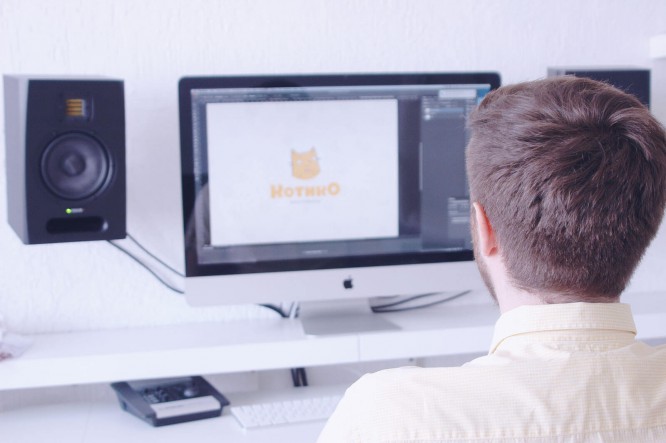The role of your business in the career of a designer
The role of your business in the career of a designer
Graphic designer Arseny Dmitriev told his story about how the business he created influenced his career as a designer: why everyone should try to launch their own project at least once in their life, work with other designers as a customer, and how this will affect professional growth.
Having my own online store nearly ruined my design career. For more than a year and a half, I have been combining commerce and creation. But the store took up too much time and in 2014 I faced a difficult choice: to abandon the development of the project or leave the studio.
And I stayed in design. But I do not regret the time spent on the commercial project. He taught me a lot, without which I would not have taken place in my profession.
I will say more: I recommend that anyone who plans to succeed in the design world try to create something of their own. This will help you acquire invaluable skills.
You will understand your customers
Working on your own project, you will understand that a lot depends on the decisions you make. Including your well-being. This understanding will make you work and live your business 24/7.
While developing an online store, I obsessively studied literature on business and design, studied the Internet, met new people, learned from experience, looked through the designs of Western and Russian online stores. I killed hundreds of hours on this, but I got an experience that still helps me make difficult decisions.
 7 Habits of Proactive People by Stephen R. Covey. The best book to start with and reread at least once a year
7 Habits of Proactive People by Stephen R. Covey. The best book to start with and reread at least once a year
I learned to justify ideas, create commercially viable concepts. Simple “beautiful and stylish” is no longer enough. It cannot be otherwise, if every action you take determines what will be on your table tomorrow: a crust of bread or a steak of marbled beef.
Customers think the same way. They are not interested in having a cool project in your portfolio. They want a profit, they want to move their business forward and therefore find fault with insignificant trifles.
Running your own project will help you look at many issues from the other side of the barricades. Knowing how your customer thinks, you can anticipate answers to some questions and make decisions faster. You will begin to look for proposals that will give real, tangible results. I’ll say more: if you learn to look at the world through the eyes of clients, you will be able to convince them of the correctness of the ideas put forward. Dream, isn’t it?
You will learn to prioritize
If your life is spoiled by perfectionism and the desire to do everything at once, try yourself in business.
Acting as a customer, I pestered the programmers with crazy ideas to improve the online store. I generated innovation at the speed of a jet. But 80% of them were useless and even destructive. They hammered my head and distracted me from solving urgent issues.
I would have lost my mind if I had not discovered the concept and meaning of priorities. It was hard to cross out seemingly brilliant thoughts from a notebook, but I began to understand what to do first, and what is better to score on.
We live in a ruthless world where budget and time are valued above ephemeral ideas. It forces us to sacrifice something, to postpone something. If you learn to prioritize, you will do it without regret or heaviness in your heart.
You will explore related areas
You will have to deal with hiring programmers, SEOs, copywriters and other people. And if you do not know how to think with complex functions and algorithms, then you will have a hard time. All these guys think in different categories, speak a different language. Sometimes you find yourself in the position of a tourist with a phrasebook: it turns out to ask a question and convey your idea, but not to interpret and understand the answer.
I’m lucky. There were many programmer friends and SEO specialists in the notebook who agreed to help. They gave advice, sometimes they did something for my online store. But constantly jerking friends on small issues is not an option. Hiring them is to jeopardize the very fact of friendship.
And then I again had a choice: to master the basic concepts of related areas or leave development to its own devices and hope for the best. Needless to say, what decision did I make?
I sat down to books again. My first layout job was a page for social campaigns to support stray animals. Curve, oblique, but the page provoked a response not only among customers. People brought medicines, food and other supplies for stray animals.
Solving a practical problem, I tried to understand the way of thinking of programmers, the principles of their work, to partly master the tools that they use. I began to think wider. Lately I’ve been catching myself thinking that “coding” is many times more pleasant than moving pixels.
Now I take into account the subsequent development process in the design. I agree in advance with the customer some of the “prettiness” features, think over the cutting of graphics, look for plugins and code templates. I am happy to take on the frontend. No more broken phone. I freely communicate directly with programmers and layout designers, even if they work on the customer’s side. This helps build a productive business dialogue.
Your own project will take you out of your comfort zone. You will stop thinking only in terms of contrast, color, and fonts. You will learn about cross-browser compatibility, responsiveness, site load time, server load, and much more. By understanding related areas, you will learn how to resolve contradictions and find compromises.
You will learn the Zen of typography
If you know at least one online store that works successfully without graphical support, send me a link to it. This routine process for a designer looks different from the side of the business owner.
Ads, printed materials, promotions, ideas for these promotions, contests on social networks – all these make money. It makes you move, think, experiment and go beyond.

One way or another, as the owner of the project, you will have to visit a printing house, learn the rules for preparing layouts for printing, learn to save money and understand the types of paper, the quality of printing. You will see how an interesting idea turns into a completely real working booklet. It inspires and helps to avoid silly mistakes when working in graphic editors and to experiment with layouts.
Even basic knowledge of typography will add value to your client or future employer.
You will learn to get along with people
I had to test all ideas in practice and see how people react to them. I worked according to the scheme: I came up with it – I tried it – I drew conclusions. To get full feedback, I replaced the courier and worked on the delivery.
 Sometimes I had to wander around the city a lot: to warehouses, to customers and back.
Sometimes I had to wander around the city a lot: to warehouses, to customers and back.
Sometimes you load the car completely with goods, so much so that it falls on your head from the back seats, and forward through the city. Traffic jams, rain, heat, endlessly ringing phone, rush, nerves. Courier work is very different from sittings at the computer.
This is how I met people of different social classes. Each of them required a different approach. I had to find a common language, solve problems on the spot, smooth out conflicts. It didn’t always work out.
A little secret. A personal contact is required with the customer. I found confirmation of this idea in Michael Janda’s book “Burn Your Portfolio!” Phone, Skype, mail – nonsense. If you have a difficult question, meet and find a solution.
Knowing how to negotiate with people, you will learn to trust them. It is important. Indeed, at a certain stage of development, you will have to delegate work to others. Without trust, this process will turn into torture.
If you’re having trouble communicating, dive into your own project! Don’t hire a secretary, go to the forefront of the business, solve problems on the spot. In the future, being able to communicate will save you a lot of time, money and nerves.
Does every designer need this?
Not. Those who plan to outgrow the level of most designers and become a full-fledged partner for their clients need their own business. Only such people are entrusted with interesting and special projects.
If you still want to draw business cards all your life, don’t do anything.
Well, if you are suddenly going to achieve something in design, you have to:
- see the world through the eyes of a client… It is not enough to complete the task beautifully, the designer needs to solve the client’s problem;
- prioritize and build processes… The designer must see solutions that will bring maximum results with minimum costs);
- understand many related areas… A good web designer makes up your own layouts, and you will already have more opportunities to implement your ideas;
- comprehend the intricacies of typography… Even basic knowledge of typography will increase your value in the eyes of a client or future employer;
- learn to negotiate… The ability to build a dialogue with a customer will sooner or later turn a designer into an art director.
Your own, even the simplest business is an affordable and comprehensive way to achieve these goals. It will kill the dreamy theorist in you and turn you into a pragmatic but highly paid practical designer. Proven from personal experience.
Source: grabli.arsdmitriev.ru
…

